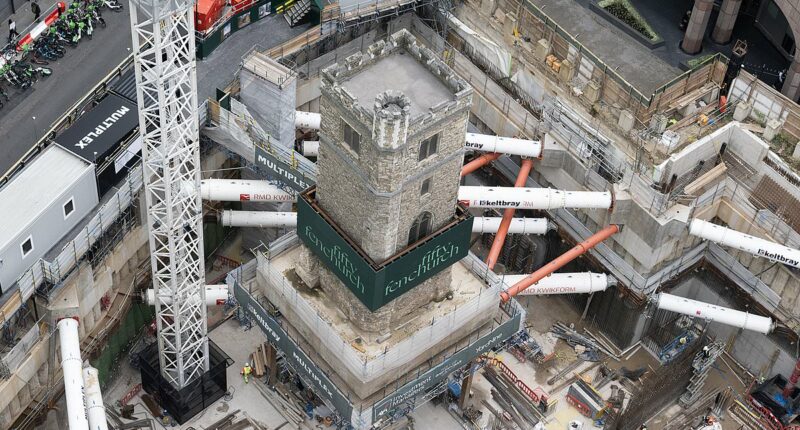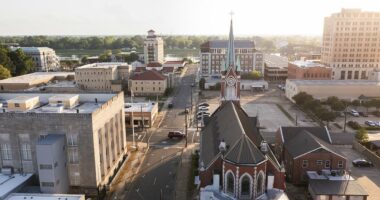Share this @internewscast.com
Some things were built to last. Stonehenge. The Colosseum in Rome. The Great Pyramid of Giza in Egypt.
And also, it seems, All Hallows Staining, a teeny church tower near Fenchurch Street station in the City of London.
Constructed from stone in 1320, it has surpassed the reigns of numerous English monarchs and withstood both the Great Fire of London and the Blitz, which destroyed many nearby structures.
It stood firm during the Black Death and through the Renaissance, Reformation, Counter-Reformation and Civil War.
It has also remained steadfast through the Industrial Revolution, two World Wars, the era of The Beatles, the moon landing, and even the rise of Taylor Swift.
Presently, it stands proudly, with its small wooden door locked, dark mullioned windows shining in the sunlight, and its stone facade and neat grey drainpipe in pristine condition.
But no longer on solid earth.
At the moment, the 700-tonne stone tower is ‘floating’ approximately 17 metres (equivalent to three double-decker buses) above a substantial £1 billion project known as Fifty Fenchurch. This project is developed by AXA IM Alts, a notable investment management firm, and designed by the British firm Eric Parry Architects.

Jane Fryer visits All Hallows Staining church in Fenchurch Street and gains exclusive access to the building site below the church

The 700-tonne stone tower is ‘floating’, about 17 metres above a vast £1billion construction site called Fifty Fenchurch

Constructed from stone in 1320, it has surpassed the reigns of numerous English monarchs and withstood both the Great Fire of London and the Blitz, which destroyed many nearby structures.
Beneath it, as I discovered during a hard hat tour of the site last week, there is a 90 by 60-metre void, excavated by developers who extracted 125,000 tonnes of earth, equating to over 8,300 lorryloads.
By 2028 the site, leased to AXA by The Clothworkers’ Livery Company, who have owned it since 1870, will be home to a 36-floor skyscraper with open balconies throughout, a hanging garden for the public on the 10th floor, shopping area, public space and – due the demolition of their 500-year-old home – a new underground Livery Hall for the Clothworkers’ Company.
And All Hallows.
Which is not actually floating above my head – even though when I stand beneath it and gaze up at the huge chunks of chalky foundations still attached, it appears to be.
Because, well, that would be bonkers.
Instead, and almost as mad, it is supported – in its original position – by 26 underpins, perched on a huge slab of concrete (six metres across, two deep and weighing 100 tonnes) and held up by four gigantic steel stilts, which travel another 15 metres below ground.
And the whole lot is supported by a crazy-looking network of thick red and white tubes that zig-zag across the site.
Meanwhile, as dozens of highly skilled construction workers beaver below, filling the air with dust and noise and the sweet smell of concrete, the tower is monitored constantly and closely, like a patient in Intensive Care.
‘We have instruments dotted all over the walls of the tower and a remote digital station that takes readings every day to monitor the position of each of the walls,’ says Mike Thomson from site engineers Arup.
‘We can see if anything is moving downwards or sideways.’
So far – thank goodness – nothing.
Which is a good thing because, while the nave collapsed in 1671 (possibly due to the number of Black Death burials undermining the foundations), and Nikolaus Pevsner dismissed it in his guide to the City of London as a ‘humble and much-restored medieval tower’, All Hallows is Grade I-listed, which means that it cannot be demolished, dismantled or moved even an inch.
So instead the developers had to work around it. It goes without saying that the whole project has created quite a stir.
Not just among passers-by who crane and stare over the barriers and take endless photos from the amazing hanging garden on the 15th floor of 120 Fenchurch across the road (also designed by the brilliant Eric Parry).
But also in the news, on radio and all over social media where, for once, reaction to this extraordinarily ambitious project is uncharacteristically proud and supportive.
‘This screams London!’ writes one fan.
‘Preservation at its finest!’ writes another. ‘Proud to be British! No city mixes new and old like London.’
Not that the developers, or architects, had much choice.

The church is supported – in its original position – by 26 underpins, perched on a huge slab of concrete (six metres across, two deep and weighing 100 tonnes) and held up by four gigantic steel stilts, which travel another 15 metres below ground

By 2028 the site, leased to AXA by The Clothworkers’ Livery Company, who have owned it since 1870, will be home to a 36-floor skyscraper. Pictured: A CGI image of the finished building

How the tower will look, left, in a garden with shops and cafes when the project ends in 2028
‘Of course we wouldn’t do this anywhere else. But then you don’t usually have 14th Century towers sitting in the middle of your site – which is quite exciting, but comes with its challenges’ says architect Eric Parry.
‘There’s no way it could be moved after surviving everything that has been thrown at it since the 14th Century.’
At one time All Hallows was one of eight Stainings (churches built of stone) in the City of London, but now is one of only three standing (or floating). And today as pile drivers and metal cutters and generators throb below, every so often the team pause to admire it.
‘It is a very simple structure. But it was built incredibly well. Look at those foundations!’ says Mike Thomson, pointing up at the clumps of still-attached chalk.
‘It was built really well, really solidly. That’s why it lasted.’
Throughout the process, Mike insists, there was never a moment when they stepped away and thought, ‘Oh blimey, is it going to hold?’
‘Because we haven’t lifted it. We haven’t moved it,’ he says.
He explains that first the foundations were meticulously underpinned, or strengthened, by 26 individual two-metre concrete blocks which were installed beneath the tower, one at a time, accessing via ladders and pits from street level, before the basement was excavated.
By installing the blocks one by one, the tower never had much of the existing ground removed from under it at once.
‘As with all buildings, there was the tiniest shift as it settled into the underpinning,’ he says.
Once the blocks were all connected with steel reinforcements to form a new 100-tonne reinforced concrete ‘raft’ slab, this was attached to the four stilts that had already been driven into place outside the base of the tower.
As Mike explains, only then did they dig away the ground that had been supporting the church tower.
‘I had originally envisaged the tower being supported by a single column, but the engineers didn’t like that,’ says Eric. ‘But that was the only part of my vision that they pushed back on.’
Right now, construction workers are busy on 21st Century foundations, built with thousands of steel rods and concrete still warm to the touch.
The scale is extraordinary – towering cranes swing steel rods around like bits of balsa wood. Huge yellow skips look like Tonka toys.
And this is just the basement. The main skyscraper will stretch 36 floors up. Taller than all the surrounding buildings.
The site was also home to Lambe’s Chapel Crypt. Dating from around 1200, it has been dismantled but will be reinstated as part of the build.
Today it is all quite hard to imagine. Not least because of the giant tubes everywhere, which look like the results of a drunken Meccano game but have been meticulously placed by engineers to stop the entire site collapsing into a heap of rubble.

An illustration of All Hallows Staining church from the magazine The Illustrated London News, volume LVI, June 11, 1870
‘There are thousands of tonnes of force in each tube and they stop the surrounding streets and buildings from falling into the hole,’ explains Rob Samuel, head of Development for UK and Ireland for AXA.
‘Sewers, gas pipes, water pipes, buildings, nothing can move.’
The juxtaposition between old and new, shiny new glass and dark medieval alleys in the City of London has always been astonishing.
The whole place is steeped in history and money. It has been a trading centre since Londinium was established in about AD50.
As the AXA team excavated the site, with archaeologists on hand, they went back 2,000 years.
‘It’s a cross section of history,’ says Mr Samuel.
‘We found bits of Roman mosaics and columns, a halfpenny from the reign of Edward I [1272-1307], right up to a bone comb which was all the rage in Victorian times.
‘Layers and layers of London history. We found everything other than a dinosaur, thank goodness.’
Because the remains of a T-Rex would definitely have halted the project, which miraculously, after eight years, is on track, on budget and promises to be breathtaking.
Because, when the project is finished in 2028, the church will be safely back on solid ground again to form the centrepiece to a new public garden square with shops and cafes.
The Clothworkers will have a beautiful new hall down below.
And above, the skyscraper will gleam in the sunlight as workers and members of the public eat their sandwiches on the 10th floor hanging garden and admire the gleaming cityscape.
Today’s buildings are estimated to last approximately 60 years.
This little tower has been here more than 11 times that. ‘It will outlast them all, I guarantee that,’ says Eric, ‘because it was built to last.’
As it floats in the 21st Century sunshine, it is little wonder that All Hallows has become a symbol of resilience and endurance.
But more importantly, this whole extraordinary project has unlocked a fierce (and increasingly rare) pride – in our history, our heritage, our brilliant British madness and a crazily audacious and ambitious plan, perfectly executed.
















